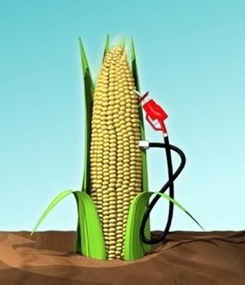
Ethanol also known as ethyl alcohol or grain alcohol, can be used either as an alternative fuel or as an octane-boosting, pollution-reducing additive to gasoline. Ethanol is actually liquid alcohol made of oxygen, hydrogen and carbon and is obtained from the fermentation of sugar or converted starch contained in plants, grains and other agricultural products.
In the U.S., ethanol is primarily produced from the starch contained in grains such as corn, grain sorghum, and wheat through a fermentation and distillation process that converts starch to sugar and then to alcohol. Ethanol is the most widely used biofuel today.
Currently, a majority of ethanol is made from corn, but new technologies are being developed to make ethanol from other agricultural and forestry resources such as:
- corn stover (stalks and residues left over after harvest)
- grain straw
- switchgrass
- quick growing tree varieties, such as poplar or willow and municipal wastes.
Ethanol can also be produced from fibrous cellulosic biomass materials, such as grass, vineyard grapes, wood, crop residues, or old newspapers. Breaking these materials down to their component sugars for subsequent fermentation to ethanol is a major focus of U.S. Department of Energy research. Whether made from starch in corn grain or cellulose in corn stalks, ethanol is a renewable, domestic biofuel.
Ethanol is a high-octane fuel. Octane helps prevent engine knocking and is extremely important in engines designed to operate at a higher compression ratio, so they generate more power. These engines tend to be found in high-performance vehicles. Because ethanol has high octane, it is sometimes blended with gasoline in small amounts to boost octane rating. This mixture, in turn, can be used in high-performance engines.
Most of today's commercially available vehicles can run on blends of E10, a blend of 10 percent ethanol and 90 percent gasoline, or lower. E10 is the most common low concentration blend. Many areas of the country mandate its use as a replacement for MTBE.
Ethanol can be blended with gasoline in varying quantities to reduce the consumption of petroleum fuels, as well as to reduce air pollution. It is increasingly used as an oxygenate additive for standard gasoline, as a replacement for methyl t-butyl ether (MTBE), which is responsible for groundwater and soil contamination.
E85: What is it?
Ethanol is blended with gasoline to create E85, a blend of 85 percent ethanol and 15 percent gasoline. Due to the corrosive affects of E85, because of its high alcohol content, traditional vehicles cannot use E85. Flex fuel vehicles (FFVs) have engines modified to accept higher concentrations of ethanol. Such flexible-fuel engines are designed to run on any mixture of gasoline or ethanol with up to 85 percent ethanol by volume.
E85 (85% ethanol, 15% gasoline) is considered an alternative fuel under the Energy Policy Act of 1992. It is used to fuel E85-capable flexible fuel vehicles (FFVs), which are available in a variety of models from U.S. and foreign automakers.
Other than lower gas mileage, motorists will see little difference when using E85 versus gasoline. E85 has about 27% less energy per gallon than gasoline. For more information on ethanol's energy content, see the E85 Fuel Properties section. Use the FFV Cost Calculator to quantify the effect of E85's lower energy content on FFV fuel economy and fuel costs.
E85 Gas Stations
As of early 2007, nearly 1,200 U.S. fueling stations offered E85 to the more than 5 million FFVs on U.S. roadways. Stations are more common in the corn belt (Minnesota, Iowa, Illinois) but are spreading throughout the country. In fact, E85 is now offered in 40 states. See E85 Fueling Station Locations for sites near you. E85 typically costs about the same or slightly less than gasoline on a gallon-for-gallon basis.
 Print
Print Email
Email







